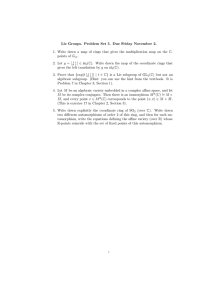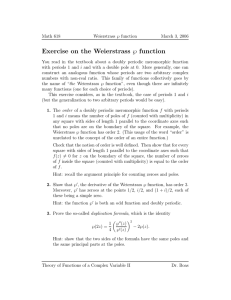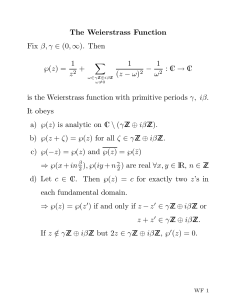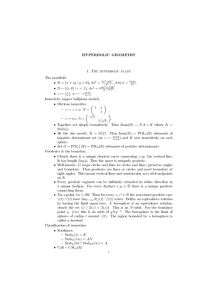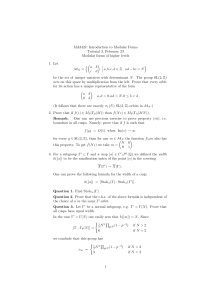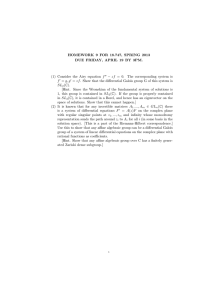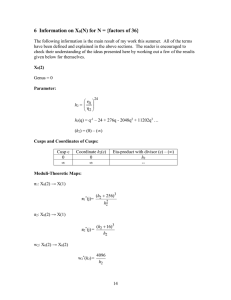Math 613: Problem set 4 (due 18/10/09) The weight-k action a
advertisement
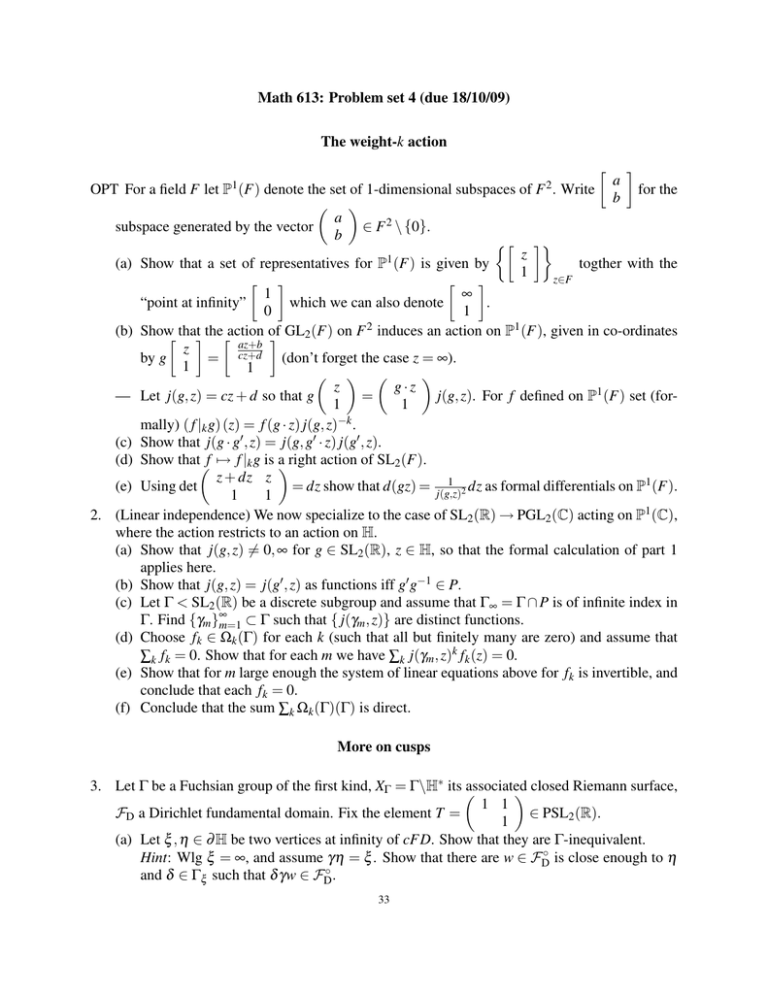
Math 613: Problem set 4 (due 18/10/09)
The weight-k action
OPT For a field F let
P1 (F)
F 2.
a
b
denote the set of 1-dimensional subspaces of
Write
for the
a
subspace generated by the vector
∈ F 2 \ {0}.
b
z
1
(a) Show that a set of representatives for P (F) is given by
togther with the
1
z∈F
∞
1
.
which we can also denote
“point at infinity”
1
0
(b) Show that theaction of
GL2 (F) on F 2 induces an action on P1 (F), given in co-ordinates
az+b
z
by g
= cz+d (don’t forget the case z = ∞).
1
1
z
g·z
— Let j(g, z) = cz + d so that g
=
j(g, z). For f defined on P1 (F) set (for1
1
mally) ( f |k g) (z) = f (g · z) j(g, z)−k .
(c) Show that j(g · g0 , z) = j(g, g0 · z) j(g0 , z).
(d) Show thatf 7→ f |k g is aright action of SL2 (F).
z + dz z
1
1
(e) Using det
= dz show that d(gz) = j(g,z)
2 dz as formal differentials on P (F).
1
1
2. (Linear independence) We now specialize to the case of SL2 (R) → PGL2 (C) acting on P1 (C),
where the action restricts to an action on H.
(a) Show that j(g, z) 6= 0, ∞ for g ∈ SL2 (R), z ∈ H, so that the formal calculation of part 1
applies here.
(b) Show that j(g, z) = j(g0 , z) as functions iff g0 g−1 ∈ P.
(c) Let Γ < SL2 (R) be a discrete subgroup and assume that Γ∞ = Γ ∩ P is of infinite index in
Γ. Find {γm }∞
m=1 ⊂ Γ such that { j(γm , z)} are distinct functions.
(d) Choose fk ∈ Ωk (Γ) for each k (such that all but finitely many are zero) and assume that
∑k fk = 0. Show that for each m we have ∑k j(γm , z)k fk (z) = 0.
(e) Show that for m large enough the system of linear equations above for fk is invertible, and
conclude that each fk = 0.
(f) Conclude that the sum ∑k Ωk (Γ)(Γ) is direct.
More on cusps
3. Let Γ be a Fuchsian group of the first kind, XΓ = Γ\H∗ its associated
closed Riemann surface,
1 1
FD a Dirichlet fundamental domain. Fix the element T =
∈ PSL2 (R).
1
(a) Let ξ , η ∈ ∂ H be two vertices at infinity of cFD. Show that they are Γ-inequivalent.
Hint: Wlg ξ = ∞, and assume γη = ξ . Show that there are w ∈ FD◦ is close enough to η
and δ ∈ Γξ such that δ γw ∈ FD◦ .
33
— Conclude that the vertices at infinity {ξk }K
k=1 of FD are representatives for the Γ−equivalence
classes of cusps of Γ.
(b) For each k let σk ∈ SL2 (R) be such that σk ∞ = ξk . Show that σk−1 FD ∩ {y(z) > Y } is a
vertical strip [x0 , x0 + h] × (Y, ∞) for Y large enough.
Hint: Consider the two sides meeting at the vertex ξk .
OPT Show that we can choose σk such that σk−1 FD ∩ {y(z) > Y } = − 12 , 21 × (Y, ∞) and that
in that case the image of σk−1 Γξk σk in PSL2 (R) is the group generated by T .
S
(d) Set Fk,Y = σk − 12 , 21 × (Y, ∞) and FY = FD \ k Fk,Y . Show that for Y large the Fk,Y are
disjoint and FY is compact.
4. The invariant height on Γ\H is defined by
yΓ (z) = max max y (σk γz) .
k
γ∈Γ
(a) Show that maxγ∈Γ y (σk γz) is finite and continuous.
Hint: By problem set 3, problem 8(c) the set of y-values is discrete and bounded above.
(b) Show that yΓ is a continous Γ-invariant function on HH. Show that yΓ (zn ) → ∞ if zn
approach a cusp.
(c) Show that {z ∈ Γ\H | yΓ (z) ≤ Y } is compact, and that if yΓ (zn ) → ∞ then there is a subsequence which converges to a cusp.
Hint: The first part is variant of 3(d).
5. Let f ∈ A0 (Γ) = C(XΓ ) be a meromorphic function on XΓ .
(a) Show that for Y large enough f has no zeroes or poles in the region yΓ (z) > Y .
— Assume now that Y is also large enough for 3(d) to hold. Let CY be the contour that goes
along the boundary of FD except
that at each cusps one truncates the cusp along the curve
S
yΓ = Y , and write CY = C0 ∪kCk where C0 = CY ∩ ∂ FD and Ck is the closed horocycle at
the kth cusp.
f0
1 H
(b) Show that 2πi
C0 f dz = 0 using the side-pairings and the invariance of yΓ .
0
f
1
(c) Evaluate 2πi
Ck f dz in terms of the behaviour of f at ξk by mapping the cusp neighbourhood to a punctured disk.
f0
1 H
(d) Since 2πi
CY f dz counts the zeroes and poles in FY , show that f has the same number of
zeroes and poles in XΓ .
R
6. X(1) = Γ(1)\H∗ . We have seen in class that j : X(1) → P1 (C) is a biholomorphism. In
particular, all values are simple.
(a) Let f ∈ A0 (Γ(1)) be non-constant. Construct g ∈ C( j) such that f , g have the same zeroes
and poles in Y (1).
Hint: j(z) − j(z0 ) has a simple zero at z0 , a pole at the cusp, and no other zeroes or poles.
(b) Show that gf has no zeroes or poles in Y (1), and conclude that it has no zeroes or poles in
X(1).
(c) Applying the maximum principle show that gf is constant and conclude that C(X(1)) =
A0 (Γ(1)) = C( j).
34
On the choice of σξ
7. Let Γ be a Fuchsian group with a cusp ξ , and let σ , σ 0 ∈ SL2 (R) such that σ ∞ = σ 0 ∞ = ξ .
Let f ∈ Ωk (Γ).
(a) Show in the definition of f being meromorphic/holomorphic/vanishing at ξ using σ or σ 0
would not change the conclusion.
(b) Assume that f is meromorphic at ξ or holomorphic on H. In either case show that the
Fourier expansion of f at ξ is essentially independent of the choice σ or σ 0 . Is the expansion truly independent of the choice?
The cusps of congruence subgroups
8. Let Γ be a Fuchsian group, and let Γ0 be a subgroup of finite index.
(a) Show that Γ and Γ0 have the same cusps.
(b) Let ξ be a cusp of Γ. Show that the Γ0 -equivalence classes of cusps which are Γ-equivalent
of ξ are in bijection with the double coset space Γ0 \Γ/Γξ .
(c) Let ΓN < Γ0 be normal in Γ, and write bars for the image in the quotient group Γ̄ = ΓN \Γ.
Show that the map Γ → Γ̄ induces a bijection Γ0 \ΓN /Γξ → Γ0 \Γ̄/Γξ .
9. Let Γ(1) = SL2 (Z) and recall its subgroups Γ(N) < Γ0 (N) < Γ1 (N) from Problem set 3.
(a) Show that the cusps of Γ(1) are precisely P1 (Q) = Q ∪ {∞} ⊂ R ∪ {∞} = ∂ H, and that
Γ(1) acts transitively there.
— Let Γ∞ = Γ(1)i∞ and let Γ+
T is the translation.
∞ = hT i where a b
(b) Let Γ̄ = SL2 (Z/NZ). Show that the map
7→ (c, d) induces a bijection between
c d
2
Γ/Γ+
∞ and the set of elements of order N in (Z/NZ) .
Hint: This was already done in PS3.
(b) Show that X0 (N) = XΓ0 (N) has ∑d|N φ ((d, N/d)) cusps. In particular, for p prime X0 (p)
has two cusps – in this case find representatives.
OPT Count the cusps of X(N) = XΓ(N) and X1 (N) = XΓ1 (N) .
Dirichlet characters
Let N ≥ 1. A Dirichlet character mod N is a non-zero function χ : Z → C such that χ(ab) =
χ(a)χ(b), χ(a) = χ(b) if a ≡ b (N) and χ(a) = 0 whenever (a, N) > 1. We freely identify χ with
the function it induces on Z/NZ
OPT. Let χ be a Dirichlet character mod N.
(a) Show that χ(1) = 1 and that χ is non-zero in (Z/NZ)× .
(b) Show that the non-zero values taken by χ are(roots of unity.
χ(a) (a, M) = 1
(c) Let N|M. Show that the function χM (a) =
is a Dirichlet character
0
(a, M) > 1
mod M satisfying χM (a + kN) = χM (a) for all k ∈ Z. Characters mod M obtained this way
with N < M are called imprimitive. Other characters are called primitive.
(d) Assume that χM = ψM for another character ψ mod N. Show that χ = ψ.
35

